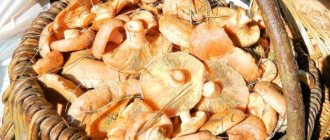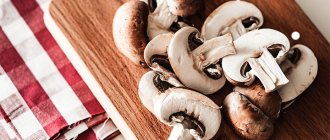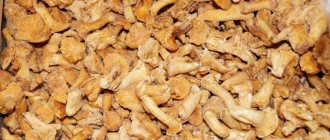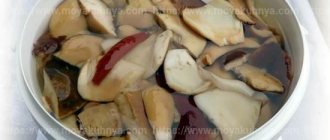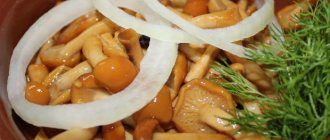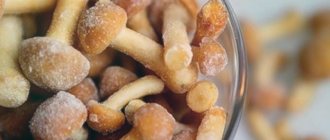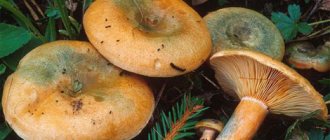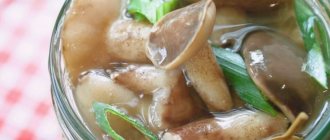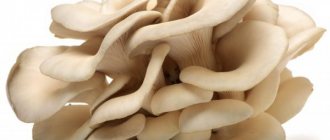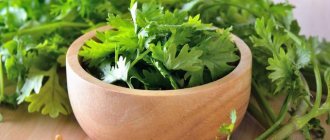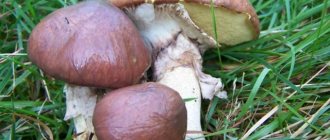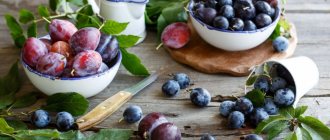Both novice mushroom pickers and experienced lovers of quiet hunting will be interested in information on how to pickle mushrooms, what types are suitable for this kind of preparation, and how to properly prepare them for pickling. A simple and affordable way to process the collected mushroom abundance will allow you to supplement your menu with an excellent snack.
What mushrooms are salted?
Having collected baskets full of fragrant gifts from the forest in the forest, and starting to process them, it is important to understand which mushrooms are salted for the winter, and which ones are better to discard and use them in everyday culinary dishes.
- All lamellar mushrooms are ideal for pickling: milk mushrooms, milk mushrooms, saffron milk caps, chanterelles, serushki, russula, autumn mushrooms and champignons.
- From the tubular ones, porcini mushrooms, boletus mushrooms, boletus mushrooms, boletus mushrooms and boletus mushrooms are pickled.
- The leader in the taste characteristics that mushrooms acquire after salting and in the valuable properties they contain are milk mushrooms. Although this type requires lengthy preliminary preparation and soaking, it is ideal for pickling.
Mushrooms for the winter. Recipes
Salted mushrooms for the winter, prepared as follows, are tasty and aromatic.
Wild mushrooms - boletuses, moss mushrooms, boletus mushrooms - are washed thoroughly in running water, then they are filled in a pan with salted water and sent to the fire. Boil the mushrooms for about 15 minutes, then remove them and cool under running cold water.
Laurel and black currant leaves, dill, garlic are placed in a pickling container, followed by a layer of mushrooms. Mushrooms are sprinkled with salt. You can add coriander seeds to the spices. Having filled the entire container in this way, the mushrooms are pressed down from above with oppression. In 5-7 days the mushrooms will be ready.
If the mushrooms are under-salted, you can simply add salt to them; if they are over-salted, then they should be soaked a little before eating and served, seasoned with garlic and vegetable oil, or sour cream.
How to prepare mushrooms for pickling?
Preparing mushrooms for pickling is an important stage, and the final result will depend on the quality of its execution. The technology for processing the base product entirely depends on the type and variety of mushroom specimens.
- Lacteal mushrooms: milk mushrooms, milk mushrooms, serushki require preliminary long-term soaking to get rid of their inherent bitterness contained in the milky juice. To do this, the prepared mushroom mass, cleared of contaminants and pre-washed, is kept in salted water for at least three days. The water is changed as often as possible, but at least three times a day.
- Lamellar mushrooms are not sorted by size, but the stems must be removed.
- Tubular mushrooms are chosen to be medium-sized or cut into several parts for better salting.
- Often, mushrooms are boiled until cooked or half cooked, adding a little salt to the water to taste.
How to salt honey mushrooms?
Process:
- Peel, wash and separate the caps from the stems.
- Salt the boiling water.
- Immerse the spores in this water for 10 minutes.
- Perform a disinfection procedure for jars.
- Drain the water and transfer the mushrooms to containers.
- Boil the oil and pour it while boiling into the vessels.
- Secure the necks with paper and transfer to the refrigerator for further storage.
Salted mushrooms - benefits and harms
The benefits of pickled mushrooms have long been proven by nutritionists and are due to the high content of proteins, all kinds of vitamins, and minerals in the product.
- The product is a nutritious and low-calorie alternative to meat, which makes it indispensable for a diet menu for weight loss.
- The high content of valuable vitamin PP in the product will improve the functioning of the cardiovascular system.
- Mushrooms are one of the few sources of solar vitamin D, which is fully preserved when salted.
- Salted milk mushrooms and chanterelles contain a natural antibiotic that will help cope with various bacterial infections or prevent their occurrence.
- All the same milk mushrooms are considered in folk medicine to be the best prevention against the occurrence of urolithiasis.
- Despite the many valuable properties, salted mushrooms should not be consumed during exacerbations of gastrointestinal diseases or with weakened digestion.
How to pickle mushrooms for the winter?
Any pickling of mushrooms for the winter has both its own individual characteristics and general points that can be applied to any other recipe.
- Mushrooms must be sorted, getting rid of wormy or spoiled fruits.
- Selected specimens are cleaned using a brush, sponge or knife, and if there is heavy dirt or sand, they are thoroughly washed under running water.
- When used as a base component for salting milkweeds, they are soaked in salted water for at least three days.
- Mushrooms are salted raw or boiled for 15-20 minutes.
- While studying methods of pickling mushrooms, they choose the best option for themselves, which they can adapt to their preferences, adding other flavorings, seasonings, spices, herbs, and herbs.
Quick pickling of mushrooms
This recipe will help you figure out how to pickle mushrooms, so that after a couple of days you can take the first sample and enjoy the excellent taste of the resulting snack. Preliminary boiling of the prepared mushroom mass will speed up the preparation of the delicacy until the fruiting bodies are ready or sink to the bottom.
- mushrooms - as many as available;
- salt - to taste;
- currant leaves, horseradish, dill umbrellas, garlic, bay, pepper.
- Prepared mushrooms are boiled in water salted to taste until they sink to the bottom.
- Drain the mushroom mass in a colander, place it in a saucepan, alternating with herbs and chopped garlic and adding salt to the layers to taste.
- Press the contents of the container with a weight.
- Pickling mushrooms lasts 3 days at room conditions, after which the appetizer is put into the cold for storage.
Cold pickling of mushrooms for the winter - recipe
To preserve the maximum amount of valuable vitamins, cold pickling of mushrooms is preferable. In this version, the appetizer can be tried no earlier than a month and a half later, but the long wait is compensated by the excellent taste of the resulting dish. Ryzhiki can be salted without adding dill and garlic - their natural taste is incomparable in itself.
- mushrooms – 2 kg;
- salt – 2/3 cup;
- garlic – 3-4 cloves;
- dill - 1 bunch.
- The mushrooms are prepared properly and placed in a container suitable for pickling, caps down.
- The layers are sprinkled with salt, topped with dill and chopped garlic.
- Press the mushroom mass with a weight, leave until the juice separates for 1-3 days at room conditions, after which it is put into the cold for at least a month.
Hot pickling of mushrooms in jars
Read more about how to properly pickle mushrooms using a hot method. This option is for those who are afraid to prepare the product without preliminary heat treatment. After cooking in brine, the mushroom mass can be transferred to jars, which, after the contents have cooled, are taken to a cool cellar or put in the refrigerator.
- mushrooms – 2 kg;
- water – 1 glass;
- salt – 4 tbsp. spoons;
- laurel – 2 pcs.;
- cloves and black pepper – 6 pcs.;
- currant leaves – 4 pcs.;
- dill seeds – 1 teaspoon.
- Prepared mushrooms are boiled for 20 minutes in water with salt, adding pepper, cloves, bay and dill.
- Further hot pickling of mushrooms will continue in jars into which the mushroom mass with brine is transferred.
- After the containers have cooled, they are put into the cold for a month and a half.
Salted mushrooms under pressure
With classical methods of harvesting and not only using pressure for pickling mushrooms, which can be a bottle filled with water, or a heavy clean stone, which is placed on top of a plate covering the surface of the contents of the container. Special wooden barrels or enamel vessels are used as vessels for pickles.
- mushrooms – 2 kg;
- salt – 100 g;
- laurel – 2 pcs.;
- dill and currant leaves - to taste.
- The prepared mushrooms are placed in a suitable container in layers, sprinkling each with salt.
- Greens are placed at the bottom of the vessel and on top of the mushrooms.
- Cover the contents of the container with clean gauze or a piece of fabric, and determine the pressure on top.
- Leave the mushroom mass for salting for 1.5 months in the cold, changing the gauze to clean one every 3 days.
How to pickle mushrooms correctly
© RIAMO, Ivanna Borovets
You can pickle mushrooms either “raw” or by hot processing, that is, cooking. However, the expert does not recommend salting mushrooms raw for inexperienced mushroom pickers: there is a high risk of doing something wrong. It's always better to boil the mushrooms for 15 minutes, advises Prokhorova.
Almost all mushrooms can be salted, but there are exceptions. For example, white mushrooms are not salted, but pickled, because due to their high density, the mushroom is not salted. Butter is salted separately: soaked in cold water for a day, changing the water 3-4 times, adding more salt each time. The latest mushrooms are honey mushrooms; they cannot be prepared “raw”; these mushrooms are marinated with vinegar and rolled into jars.
Lamellar mushrooms are most suitable for pickling; they are stored better and do not require such serious processing as tubular mushrooms. It is enough to wash the lamellar ones and boil them for about 15 minutes; they are not cut, they are placed whole in the jar, otherwise they will fall apart, the mushroom picker clarifies.
Lamellar and tubular mushrooms can be salted together, with the exception of black podgruzd (“nigella”). Before harvesting, these mushrooms are soaked in cold water for 6 to 12 hours, then the water is changed and boiled. You can eat them no earlier than 40 days later, when the nigellas acquire a lilac hue, and if you open the jar earlier, they will taste bitter. Tubular mushrooms can be eaten within two days after pickling.
There are two types of salting: cold and hot, says the expert. When “cold”, boil the washed, sorted mushrooms in a saucepan for 10-15 minutes, then drain the water and rinse the mushrooms with cold water, let them stand at room temperature to cool completely.
Separately, cook the brine: add 50-80 grams of salt to the water per 1 kilogram of mushrooms, depending on the type of storage. If you store salted mushrooms in a cold place, add less salt; if in a cool place, add more. Boil spices in salted water: pepper, cloves, bay leaf. After this, cool the brine.
Place the boiled mushrooms in a jar, put currant leaves, garlic, dill on top or in layers between the mushrooms, then fill with cold brine to the top, make sure that all the mushrooms are saturated with it, close the jar with a plastic lid and put it in the refrigerator or cellar.
“To make the mushrooms sour better, you can leave the jar to stand at room temperature until the morning, then put it in a cool place,” advises Prokhorova.
During “hot” salting, the mushrooms are washed, sorted, and cut, except for the lamellar ones. Lamellar mushrooms are carefully processed. Next, cook the mushrooms with salt (20-30 grams per kilogram of mushrooms) over low heat for no more than two hours, otherwise the beneficial properties will disappear. After the brine is drained, the mushrooms are washed, cooled and the second part of the salt is added and allowed to cool.
“If we put mushrooms in a jar, we pack them tightly so that the brine, coming out of the mushrooms, covers them completely. On top we put currant leaves and old dill with “umbrellas”, dill seeds, garlic,” Prokhorova clarifies.
How to store salted mushrooms?
It is important not only to properly prepare the snack, but also to store salted mushrooms at home in accordance with all requirements.
- Salted mushrooms are often stored in the same container in which the salting process took place. In some cases, the workpiece is transferred to jars, making sure that the fruits are completely covered with brine.
- For better preservation, a layer of calcined and cooled vegetable oil is often poured into the container with the workpiece.
- For long-term storage, the snack is placed in a cool room with a constant temperature of +1 to +5 degrees. This could be a refrigerator or a cool cellar.
- You cannot store mushrooms, or pickle them, in metal or clay containers. Ideal containers are wooden barrels, tubs, enamel or glass containers. When choosing enamel dishes, check the integrity of the enamel and at the slightest hint of chips, look for another vessel.
In traditional Russian cuisine, mushrooms occupy a special place, since in terms of their nutritional value they can serve as a worthy alternative to meat, fish or seafood. Mushrooms have excellent taste and a unique aroma, and thanks to the high content of plant proteins, vitamins and microelements, they help make a regular, lenten or vegetarian menu more satisfying and varied. In order to have a supply on hand for the whole winter, during the harvesting period it is customary to salt, pickle, dry or freeze mushrooms.
More than 200 species of edible mushrooms grow on the territory of Russia, of which only 57 are allowed for industrial harvesting and are included in the standards for mushroom products. The full list is given in the sanitary rules SP 2.3.4.009-93 (current edition of 1993), developed by specialists from the Institute of Nutrition of the Russian Academy of Medical Sciences, Moscow State University. M.V. Lomonosov and the State Committee for Sanitary and Epidemiological Surveillance of the Russian Federation. Based on nutritional value, mushrooms are divided into 4 categories:
- 1 - 2nd - edible. Regular cooking is enough for them;
- 3 - 4th - mostly conditionally edible. They require pre-soaking or boiling in several waters to eliminate caustic or bitter substances contained in their fruiting bodies.
The first category includes only 3 species: white mushroom (Boletus edulis), saffron milk cap (Lactarius deliciosus) and milk mushroom (Lactarius resimus).
The second group consists mainly of tubular (or spongy) - boletus, boletus, boletus, and Polish. Of the lamellar mushrooms, this includes champignons (common, field, cultivated), milk mushrooms (yellow, aspen) and white milk mushrooms.
Numerous russulas, moths, rows, oyster mushrooms, chanterelles, honey mushrooms, pigweeds, moss mushrooms and other widespread species are included in categories 3 and 4 as conditionally edible.
With a huge variety of mushrooms, the situation is further complicated by the fact that the same species can have different names depending on where it grows. For example, valui (from the Russula family) in some regions is called goby, plakun, uryupka, and in others - svinur, cowshed, kubar, podtopolnik, etc.
If you are not well versed in mushrooms, do not take everything that comes to hand in the forest. Edible varieties are easily confused with inedible or poisonous ones, which can cause serious poisoning. It is dangerous to eat even edible mushrooms when they are overripe, spoiled or softened.
Experienced mushroom pickers usually take only 5-10 species that are well known to them for food and preparations, using each mushroom for a specific purpose.
Tips for pickling mushrooms at home
Recommendations from experienced mushroom pickers:
- When sorting fruit bodies before salting, you need to select only whole and young ones without signs of damage. The edges of the old caps will be soft and tasteless.
- Soaked mushrooms weigh more than fresh ones - this must be taken into account when distributing salt.
- It is important to set the “correct” pressure - for a workpiece weighing 5 kg you need to prepare a load of 1 kg.
Whatever method you choose for preparing butter, you must first remove the film from the caps. If you don't get rid of it, bitterness will appear in the taste. To speed up cleaning, immerse the butter for 3 minutes in boiling salted water with citric acid (per 1 liter of liquid - 20 g of salt and 2 g of citric acid). Remove the butter with a slotted spoon and cool immediately. After heat treatment, the film easily comes off the cap.
Interesting!
The water in which boletus or boletus mushrooms were boiled can be bottled, tightly corked and stored in a cold place, and then the decoctions can be used to prepare sauces or added to soups.
Champignon
To preserve the taste of these mushrooms, it is better not to boil them or pour boiling water over them, but to treat them with steam, then they will not lose their taste.
Ingredients:
- mushrooms - 0.5 kg;
- a bunch of dill;
- dry salad dressing - 4 packs;
- garlic - 4 cloves;
- salt - 2-3 tsp;
- bay leaf - 4 pcs.;
- peppercorns - 10 pcs.
- lemon juice - 2 tbsp. l.
- sunflower oil - 100 ml.
Step-by-step recipe with video:
- Large mushrooms are cut into 4 parts and placed in a double boiler bowl or in a water bath, after placing them in a sieve. Heat treatment time - 20 minutes.
- Grind the dill and add salt.
- Add salad dressing and finely chopped garlic.
- Mix everything and put it in a bowl.
- Add oil, lemon juice, pepper and bay leaf. There is no need to crumble the latter.
- Place the champignons, distributing the dressing evenly. Leave for a day under pressure at room temperature.
Attention!
You can try it in a day. If there is any left, you need to store it in the refrigerator.
Honey mushrooms
It is better to salt these mushrooms cold - then the beneficial substances and taste will be preserved. After all, this is what these mushrooms are valued for.
Ingredients:
- 1 kg honey mushrooms;
- 2 leaves of horseradish;
- 2 dill umbrellas;
- 4–5 cloves of garlic;
- 3 blackcurrant leaves;
- 50 g salt.
Step-by-step recipe with video:
- Honey mushrooms are sorted and boiled in salted water for 20 minutes. For 1 liter - 2 tbsp. l. salt.
- Place the fruiting bodies on a sieve.
- Lay out in layers - honey mushrooms, salt, and seasonings.
- When the container is full, place horseradish, currant leaves and 2 cling film bags on top. Water is poured into them. This is much more convenient than installing oppression.
- When the workpiece has cooled, it is put away on the refrigerator shelf for a week.
Interesting!
Before serving, it is advisable to season the mushrooms with onions and sunflower oil.
Volnushki
It is better to pickle these mushrooms cold. The most important thing is to maintain the ratio of tremors and salt (per 1 kg - 50 g). Spices are chosen according to your taste. If you want crispy mushrooms, add cherry and oak leaves.
After soaking for 3-4 days, the fruiting bodies are placed on a sieve. And when the water has drained, lay it out in layers, sprinkling it with salt and evenly distributing the spices. Then the oppression is installed and the workpiece is removed to the cellar.
Attention!
It is customary to prepare milk mushrooms and russula in the same way.
Saffron milk caps
These mushrooms can be salted in any way - hot, cold or dry. They are not bitter, and they do not need to be pre-boiled or soaked for days. It is enough to remove the dirt and sprinkle with salt. For 1 kg of saffron milk caps - 200 g for dry pickling.
Attention!
In the future, mushrooms can be used not only as a snack, but also for making soups or frying. To remove excess salt, simply soak them in water for 2-3 hours and rinse.
Preparing mushrooms for pickling
Salting is a universal harvesting method, suitable for all edible and conditionally edible varieties. The pickling technologies used are almost the same, but the preparatory stage has its own nuances: edible mushrooms are salted for the winter without any preliminary treatments (often without adding seasonings), and conditionally edible mushrooms must first be soaked or boiled, changing the water several times to remove bitterness and acrid taste.
The harvested crop should not be left unattended for longer than 3-4 hours. Mushrooms must be used immediately for cooking or processing. First of all, they should be sorted by type and cleaned. Many mushroom pickers recommend limiting themselves to dry cleaning, scraping or cutting off dirt from the stems and removing debris stuck to the caps with a soft brush or sponge. This is especially true for varieties intended for drying. If there is a large amount of sand, the mushrooms have to be soaked briefly in cold water, and then washed and boiled in brine.
For boiling, the brine is prepared at the rate of 1 tbsp. l. salt per 1 liter of water. Mushrooms are immersed in boiling water for 10-15 minutes. During cooking, sand settles to the bottom of the pan, and plant debris (needles, grass, leaves) rises to the surface along with the foam. Therefore, the mushrooms are not mixed intensively, but only submerged with a spoon, skimming off the foam. Then they are carefully placed in a colander with a slotted spoon, never falling out of the pan, and washed with running water.
How to salt boletus mushrooms?
young boletus
Let's figure out how to pickle mushrooms for the winter and look at another simple recipe that we use mainly for boletus and honey mushrooms.
These mushrooms are not bitter, so we just clean them. You can put the butter in water for a few minutes, then clean it and remove the top “skin.” We cut large ones.
Honey mushrooms are not difficult to clean, not counting the smallest ones. For pickling, we take small and medium honey mushrooms, the rest for frying. There is no need to soak them either. Some medium mushrooms can be cut. We don’t leave the legs long, about 2-3 cm.
We will need:
- Allspice peas;
- Black peppercorns;
- Dill with umbrellas. Approximately 1 umbrella per jar 0.5;
- Bay leaves in a pack (1 leaf per jar 0.5);
- Garlic 1-2 heads;
- Vinegar 9%. Can be made from 70%: 8 parts water and 1 part vinegar;
- Salt;
- Sugar.
When wondering how to pickle mushrooms for the winter, you need to understand that all mushrooms can be salted, absolutely. And the recipes are almost the same. Only the processing of many differs significantly, pay attention to this.
Process:
- Prepare spores for further work.
- Prepare a glass container and a smaller circle or saucer.
- Place a layer of mushrooms on the bottom, caps down, then a layer of seasonings, then repeat until the ingredients are gone.
- Cover the container with a saucer and place a small weight.
- After 24 hours, transfer the butter into vessels, fill with the liberated brine and seal with lids.
- Place them in the refrigerator for 3 weeks, and then you can serve them.
Video
We offer you several more recipes for pickling certain types of mushrooms: black milk mushrooms, valuev and russula
Marinating and salting are different processes. Read about the principles of pickling mushrooms in this article.
For several years she worked as a television program editor with leading producers of ornamental plants in Ukraine. At the dacha, of all types of agricultural work, she prefers harvesting, but for this she is ready to regularly weed, pull, shed, water, tie, thin out, etc. I am convinced that the most delicious vegetables and fruits are those grown with your own hands!
Found a mistake? Select the text with the mouse and click:
Natural toxins are found in many plants; Those grown in gardens and vegetable gardens are no exception. Thus, the seeds of apples, apricots, and peaches contain hydrocyanic acid, and the tops and peels of unripe nightshades (potatoes, eggplants, tomatoes) contain solanine. But do not be afraid: their number is too small.
“Frost-resistant” varieties of garden strawberries (more often simply “strawberries”) need shelter just as much as ordinary varieties (especially in those regions where there are snowless winters or frosts alternating with thaws). All strawberries have superficial roots. This means that without shelter they freeze to death. Sellers’ assurances that strawberries are “frost-resistant,” “winter-hardy,” “tolerates frosts down to −35 ℃,” etc. are deception. Gardeners must remember that no one has yet managed to change the root system of strawberries.
You need to collect medicinal flowers and inflorescences at the very beginning of the flowering period, when the content of nutrients in them is highest. Flowers are supposed to be picked by hand, tearing off the rough stalks. Dry the collected flowers and herbs, scattered in a thin layer, in a cool room at natural temperature without access to direct sunlight.
One of the most convenient methods for preparing a harvest of vegetables, fruits and berries is freezing. Some believe that freezing causes the nutritional and health benefits of plant foods to be lost. As a result of the research, scientists have found that there is practically no decrease in nutritional value when frozen.
How to pickle mushrooms for the winter?
Honey mushrooms, boletus and saffron milk caps, salted for the winter in this way, taste amazing.
For 1 kg of selected mushrooms you will need (when packing them in liter jars - based on each jar):
- a pair of bay leaves, - 3-5 grains of allspice; — 5-8 grains of black pepper; - 1 clove of garlic, cut into slices; — sunflower oil with flavor; - 20 grams of salt; - dill.
Pour a little water into the bottom of a clean enameled bowl, add salt and add the prepared mushrooms. Boil the mushrooms for about 25 minutes, then cool. Place a bay leaf and pepper grains in a clean, sterilized jar, then add a layer of mushrooms, a couple of cloves of garlic, another layer of mushrooms, dill, etc.
The jar is thus filled to the “shoulders”: the mushrooms are lightly crushed, the excess water that appears is drained. Place a bay leaf on top and pour vegetable oil about half a centimeter above the top layer of mushrooms.
The filled jar is placed in a whole plastic bag and closed with a lid, the bag is tied (this will prevent excess liquid from leaking out during fermentation).
How to pickle mushrooms in a pan under pressure: the hot method
Tubular and lamellar mushrooms are most suitable for pickling. The second type includes honey mushrooms, which are often chosen for harvesting for the winter due to their small size. Honey mushrooms can be salted whole, so the appetizer is not only tasty, but also beautiful. Learn how to pickle mushrooms using the hot method.
Important: do not salt mushrooms in a stainless steel or aluminum pan, as they react with the metal and release toxic substances. Use an enamel pan.
- Honey mushrooms 2 kg
- Salt 100 g
- Black peppercorns 10 pcs.
- Bay leaf 3 pcs.
- Dill umbrellas 8 pcs.
- Cherry leaves 10 pcs.
- Currant leaves 10 pcs.
- Garlic 6 cloves
- Horseradish leaves 3 pcs.
Important: if you are salting milk mushrooms - white or black milk mushrooms, volnushki, white mushrooms, valui, podoreshniks, smoothies, violins - they must first be soaked for 1-2 days in water with a small amount of citric acid. The water needs to be changed several times during this time.
How to salt milk mushrooms?
Soaked mushrooms
Process progress:
- Process the spores and prepare for further actions.
- Place the processed mushrooms in a container and add water until they are completely covered with liquid.
- Transfer the filled container to the fire and cook until it boils. Skim off foam and stir during cooking.
- After boiling, let sit for 5 minutes and place in a sieve.
- Prepare disinfected vessels, throw spices inside each one, lay out mushrooms and pour in the brine in which they were thermally treated.
- Seal the containers with lids only after the air has completely escaped from them.
- Place the vessels in an unheated place for 30 days.
Salting saffron milk caps using a cold method under pressure
How to pickle mushrooms cold? The recipe is simple. For pickling, let's take one of the most suitable varieties for this - saffron milk caps.
Cooking time: 1 hour
Number of servings: 15
Energy value of the product
- proteins – 2.4 g;
- fats – 1 g;
- carbohydrates – 0.5 g;
- calorie content – 20 kcal.
Ingredients
- saffron milk caps – 2 kg;
- salt – 100 g;
- allspice peas – 30 pcs.;
- garlic – 4 cloves;
- bay leaf – 20 pcs.;
- black currant leaves – 20 pcs.
Cooking process
- Sort the saffron milk caps, discard the rotten and wormy fruits. Cut off the bottom of the stem of the mushrooms. Place the saffron milk caps in a colander and rinse thoroughly with cold water under the tap.
- Prepare a soaking solution. Fill a large container with drinking water, dissolve salt and citric acid in it at the rate of 10 and 2 g per liter, respectively. Place the saffron milk caps in this solution and soak for two days. The solution needs to be changed several times during this time.
- After this, rinse the mushrooms again under running water. Place on a paper towel to remove excess moisture.
- Select an enamel pan of suitable volume. Place currant leaves, bay leaves, allspice and garlic on the bottom. First cut each clove into two parts. Sprinkle with half the total amount of salt.
- Place the mushrooms in the pan, caps up, and sprinkle with the remaining salt. Cover the contents of the pan with gauze and apply pressure. After a few hours, the saffron milk caps will compact a little and you can add another batch of mushrooms to them, if they all don’t fit into the pan at once.
- Leave the saffron milk caps like this for two weeks. The temperature in the room where they are located should be no higher than 20 degrees. Change the gauze that covers the mushrooms every few days.
- After this time, the oppression can be removed and the salted saffron milk caps can be placed in sterilized jars. Or you can cover with a lid and leave them in the pan.
Important: never use iodized salt to pickle mushrooms, or any other fruit. Iodine, reacting with substances released during the salting process, provokes rotting.
Housewives often have a question: how much salt to add to mushrooms so that they are well salted, tasty and can be stored for a long time? For high-quality pickling, add salt to the preparation at the rate of 50 g per kilogram of mushrooms. In this case, the variety does not matter. The main thing is that the salt is not iodized.
A universal recipe for pickling mushrooms
Just picked
Any pickling of mushrooms for the winter has both its own individual characteristics and general points that can be applied to any other recipe.
- Mushrooms must be sorted, getting rid of wormy or spoiled fruits.
- Selected specimens are cleaned using a brush, sponge or knife, and if there is heavy dirt or sand, they are thoroughly washed under running water.
- When used as a base component for salting milkweeds, they are soaked in salted water for at least three days.
- Mushrooms are salted raw or boiled for 15-20 minutes.
- While studying methods of pickling mushrooms, they choose the best option for themselves, which they can adapt to their preferences, adding other flavorings, seasonings, spices, herbs, and herbs.
This recipe will help you figure out how to pickle mushrooms, so that after a couple of days you can take the first sample and enjoy the excellent taste of the resulting snack. Preliminary boiling of the prepared mushroom mass will speed up the preparation of the delicacy until the fruiting bodies are ready or sink to the bottom.
Ingredients:
- mushrooms - as many as available;
- salt - to taste;
- currant leaves, horseradish, dill umbrellas, garlic, bay, pepper.
Preparation
- Prepared mushrooms are boiled in water salted to taste until they sink to the bottom.
- Drain the mushroom mass in a colander, place it in a saucepan, alternating with herbs and chopped garlic and adding salt to the layers to taste.
- Press the contents of the container with a weight.
- Pickling mushrooms lasts 3 days at room conditions, after which the appetizer is put into the cold for storage.
To preserve the maximum amount of valuable vitamins, cold pickling of mushrooms is preferable. In this version, the appetizer can be tried no earlier than a month and a half later, but the long wait is compensated by the excellent taste of the resulting dish. Ryzhiki can be salted without adding dill and garlic - their natural taste is incomparable in itself.
Ingredients:
- mushrooms – 2 kg;
- salt – 2/3 cup;
- garlic – 3-4 cloves;
- dill - 1 bunch.
Preparation
- The mushrooms are prepared properly and placed in a container suitable for pickling, caps down.
- The layers are sprinkled with salt, topped with dill and chopped garlic.
- Press the mushroom mass with a weight, leave until the juice separates for 1-3 days at room conditions, after which it is put into the cold for at least a month.
Read more about how to properly pickle mushrooms using a hot method. This option is for those who are afraid to prepare the product without preliminary heat treatment. After cooking in brine, the mushroom mass can be transferred to jars, which, after the contents have cooled, are taken to a cool cellar or put in the refrigerator.
Ingredients:
- mushrooms – 2 kg;
- water – 1 glass;
- salt – 4 tbsp. spoons;
- laurel – 2 pcs.;
- cloves and black pepper – 6 pcs.;
- currant leaves – 4 pcs.;
- dill seeds – 1 teaspoon.
Preparation
- Prepared mushrooms are boiled for 20 minutes in water with salt, adding pepper, cloves, bay and dill.
- Further hot pickling of mushrooms will continue in jars into which the mushroom mass with brine is transferred.
- After the containers have cooled, they are put into the cold for a month and a half.
With classical methods of harvesting and not only using pressure for pickling mushrooms, which can be a bottle filled with water, or a heavy clean stone, which is placed on top of a plate covering the surface of the contents of the container. Special wooden barrels or enamel vessels are used as vessels for pickles.
Ingredients:
- mushrooms – 2 kg;
- salt – 100 g;
- laurel – 2 pcs.;
- dill and currant leaves - to taste.
Preparation
- The prepared mushrooms are placed in a suitable container in layers, sprinkling each with salt.
- Greens are placed at the bottom of the vessel and on top of the mushrooms.
- Cover the contents of the container with clean gauze or a piece of fabric, and determine the pressure on top.
- Leave the mushroom mass for salting for 1.5 months in the cold, changing the gauze to clean one every 3 days.
The following recommendations will help you acquire knowledge of how to pickle mushrooms in wooden barrels. Oak containers are pre-soaked to swell and prevent leakage, and then rinsed with boiling water and soda. For additional sterility, the inner surface of the barrels is fumigated with juniper.
Ingredients:
- mushrooms;
- salt – 30-40 g per 1 kg of mushrooms;
- greens, bay, pepper, garlic, leaves and horseradish root (optional) - to taste.
Preparation
- A layer of salt is poured into a prepared oak barrel, herbs and spices are added as desired.
- Next, lay the mushrooms with their caps down, sprinkling the layers with coarse rock salt.
- Place the load on top.
- Salted mushrooms in a barrel will be ready for consumption in 30-45 days.
The brine used for pickling mushrooms according to the following recipe contains vinegar, which allows you to obtain the characteristic taste of the preparation, protect it from the growth of unwanted bacteria and the appearance of an unpleasant odor. The difference between the process of preparing a dish in this manner and classical marinating is the absence of sugar.
Ingredients:
- mushrooms – 5 kg;
- vinegar – 0.5 l;
- water – 0.5 l;
- salt – 60 g;
- herbs and spices - to taste.
Preparation
- Pickling mushrooms with vinegar begins with preliminary preparation and boiling of the base product until it sinks to the bottom and is ready.
- Mix water and vinegar, add salt, bring the mixture to a boil, and pour the brine over the mushrooms.
- Place the mixture in jars, cover loosely and place in the cold for salting and storage.
Another recipe for pickling mushrooms that does not contain vinegar will be presented below. Mushrooms can be added to the vessel as the initial mushroom mass settles and new fruits are collected, not forgetting to sprinkle new layers with salt and, if desired, supplement them with chopped garlic, sprigs or umbrellas of dill.
Ingredients:
- mushrooms;
- salt – 40-60 g per 1 kg of raw materials;
- dill and garlic - to taste.
Preparation
- The washed and, if necessary, soaked mushroom fruits are placed in an enamel bowl, pouring salt on the bottom and adding dill and garlic.
- Sprinkle each layer of product with coarse salt.
- Press the mass with a weight and leave until the juice is separated and the mushrooms are immersed in the brine.
- After 3-5 days, the workpiece is put into the cold for 1.5 months.
Read more about how to pickle frozen mushrooms. This version is suitable when you really want to enjoy a tasty snack, but the new harvest is still far away. Grated horseradish root and garlic will give the delicacy a special piquant taste. These same components will not allow unnecessary bacteria to develop.
Ingredients:
- mushrooms – 3 kg;
- salt – 3 tbsp. spoons;
- cloves and laurel - 2 pcs.;
- horseradish root – 40 g;
- garlic – 1 head;
- sugar and coriander - a pinch each.
Preparation
- Without defrosting, the mushrooms are placed in boiling water and boiled for 20 minutes.
- Allow the mixture to cool, then mix it with salt and the rest of the ingredients from the list and place it in jars.
- Add grated horseradish and garlic on top and place the containers in the cold.
- After 10-15 days, you can try the salted mushrooms.
The cold method involves salting without preliminary decoction. Therefore, this method is considered long.
- First, the container in which the cold salting method will be carried out is sterilized.
- Next, spices are laid out, according to need and taste preferences.
- The spore caps are laid out next to the herbs and seasonings.
- You need to lay it in layers, a layer of mushrooms - a layer of salt, and so on.
- The container is covered with gauze or any other cotton fabric.
- Next, a circle of smaller diameter is placed, and a weight load is immersed on it.
- After a few days, when the mushrooms have settled, you can add another portion of spores. But at the same time, the salting time is counted after the last laying out.
- Each type of mushroom has its own salting time, but on average it varies up to 25 days.
- Ready mushrooms can be left in the container in which the salting was done. Or you can move it into glass vessels, fix it and put it in the refrigerator or cellar.
Required:
- Mushrooms - 2 kg;
- Herbs and spices - to taste;
- Salt - 100 gr.
Process:
- Carry out work on preparing the main component and disinfecting containers for storing mushrooms.
- Layer the spore caps, salt and spices, alternating ingredients.
- Cover the top with a clean cotton rag and place the weight on a circle of smaller diameter.
- Serve within a month.
Procedure:
- Prepare the ingredients by washing and cleaning them first.
- Pour water into the container and place the spores.
- Place the container on the fire for 10 minutes.
- Next, prepare the second container by pouring in 1 liter of water and salt. Also move it to the fire until it boils.
- After the time has passed, remove the mushrooms and place in a colander.
- Move them through vessels that have been disinfected in advance.
- Add seasonings, spices and marinade inside.
- Cover the top with a waffle towel and leave for a day.
- After 24 hours of infusion, the mushrooms are ready to eat.
Is it possible to pickle mushrooms in plastic containers?
To ensure a long shelf life for mushrooms, you should take care of the container in which you salt the mushrooms. Often during the harvesting season, all suitable buckets and pans are occupied with something. Experienced housewives know that mushrooms and vegetables need to be salted in wooden, glass or enamel containers. But sometimes only plastic is left on the farm. Is it possible to pickle mushrooms in it?
You should not prepare pickles in plastic containers. Salt has a destructive effect on plastic, causing the material to release toxic substances that penetrate the food. But if this is the only vessel that is currently available for pickling, carefully inspect it and prepare it thoroughly.
How to prepare plastic containers
The first thing you need to look for on plastic utensils when inspecting them is a special symbol that shows a fork and a glass. This sign indicates that the container is suitable for storing food.
Plastic utensils may also have additional symbols indicating the specific purposes for which they can be used:
- a plate with a shower that waters it - dishwasher safe;
- snowflakes - suitable for freezing food in it;
- oven with waves - suitable for heating food in the microwave.
- PET – polyethylene terephthalate;
- HDP - high-strength polyethylene;
- PVC – polyvinyl chloride;
- LDP - low density polyethylene;
- PP - polypropylene;
- PS - polystyrene.
PVL, PP, PS and PET are plastics suitable for food storage. The remaining markings mark plastic that is used in construction, industry, and intended for other household purposes.
There is no categorical ban on the use of plastic utensils when pickling mushrooms. But if possible, it is better to refuse it. As a last resort, use it only during the pickling process, and when the mushrooms are ready, transfer them to sterilized glass jars for storage. Good luck with your preparations, delicious pickles and bon appetit!
Did you like the recipe? Save it to your Pinterest! Hover over the image and click “Save.”
How to pickle chanterelle mushrooms?
Procedure:
- Prepare the components and process the spores thoroughly.
- Place a container of water on the fire and bring to a boil.
- Place mushrooms into boiling liquid and simmer for 25 minutes.
- Then place the chanterelles in a sieve, rinse with clean water and allow to drain.
- Place spices and mushrooms in a salting container in layers, starting and ending with salt, dill and garlic.
- Cover the container with a clean cotton cloth, place the weight and place it in an unheated place.
- Store for 30 days, then transfer into glass containers. And soak before serving.
